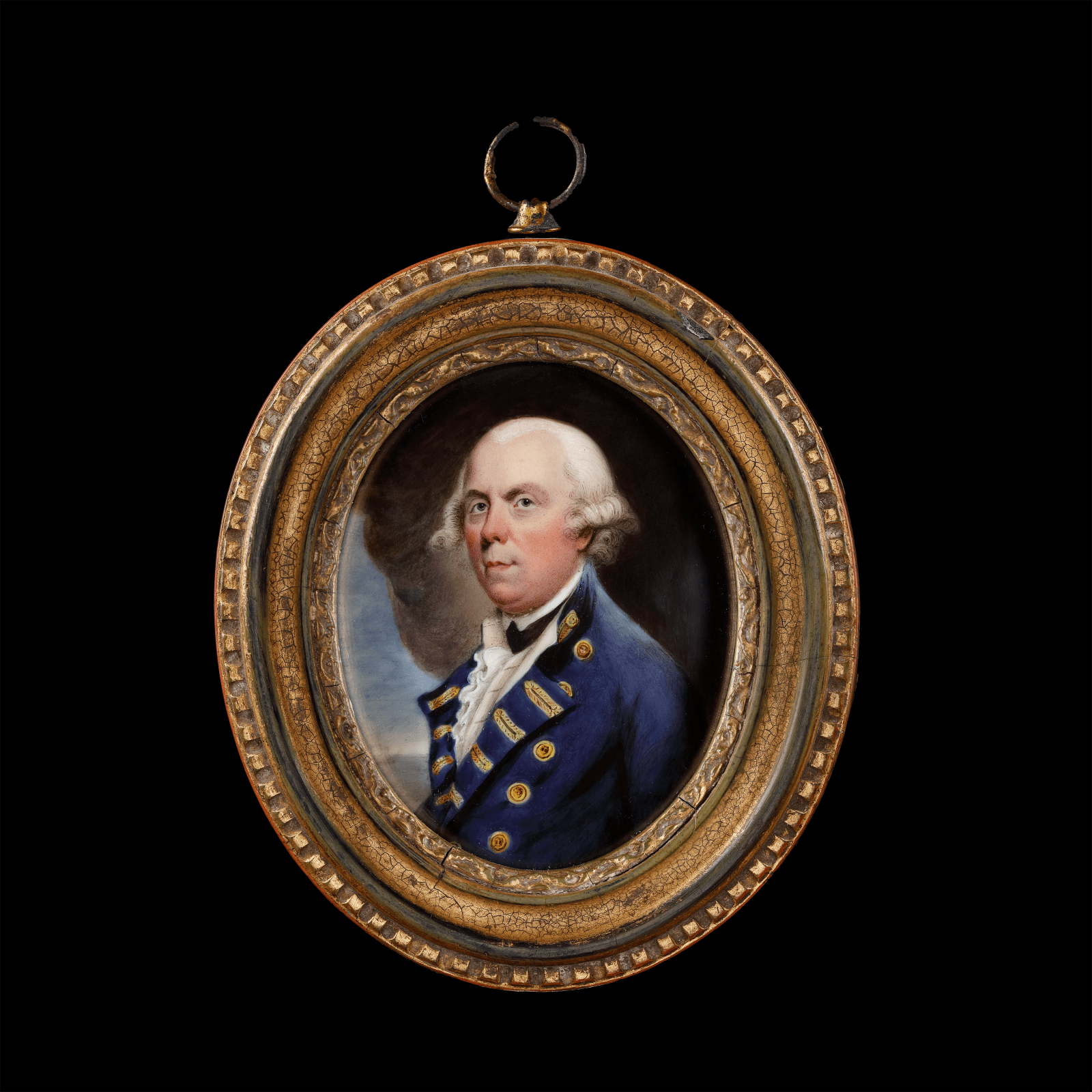
Thomas Peat
The Hon. Samuel Barrington (1729-1800) in admiral’s undress uniform, 1792
Enamel on metal
Oval, 3.4 in. (87 mm) high
Signed 'Admiral Barrington / 1792 / Peat, Painter' on counter enamel
Philip Mould & Co.
To view all current artworks for sale visit philipmould.com This enamel by Thomas Peat was taken from the 1786 oil portrait of Barrington by Gilbert Stuart (1755-1828), now in...
To view all current artworks for sale visit philipmould.com
This enamel by Thomas Peat was taken from the 1786 oil portrait of Barrington by Gilbert Stuart (1755-1828), now in the collection of the National Trust.[1] Barrington was made Admiral of the Blue the following year in 1787 and Peat’s portrait shows Barrington in this uniform and not that of vice-admiral seen in Stuart’s version. Clearly Barrington admired the portrait Stuart had made of him but wished to celebrate his important promotion. Another version of Stuart’s oil portrait was made by the miniaturist Philip Jean and engraved by Joseph Collyer. Jean published this print on 1 March 1790 with a dedication to the Duke of Clarence (the future William IV). Peat would have completed this enamel the year before Gilbert Stuart settled permanently in America, where in 1793 he moved to New York. 1792 was also the year that Peat completed his enamel of Sir Joshua Reynolds, after his self-portrait, now in the Metropolitan Museum, New York [32.75.8].
Admiral Barrington was the fourth son of John Shute Barrington, 1st Viscount Barrington (1678–1734) and Anne Daines. At the age of twelve, he entered the navy and by sixteen became a lieutenant. He saw service throughout the Seven Years War, served under Hawke in Basque Roads expedition, 1757 and under Rodney at destruction of shipping at Havre-de-Grâce. Under the Duke of Cumberland, in 1759, he served as flag-captain. Within his long career, he was in the West Indies in 1778 and almost ten years later was made Admiral of the Blue. This achievement was perhaps all the more remarkable for his noted kind-heartedness and humanity. He eventually moved to Bath where he died unmarried.
Thomas Peat may have met Barrington in person, as he worked in London but also in Bath (and the surrounding cities, including Bristol and Leamington). He worked as both enamellist and oil painter. This accomplished enamel places him alongside artists such as the better known enameller Henry Bone, although he was clearly not as prolific.
[1] Saltram, Devon, NT 872136. The prime version of Gilbert Stuart’s portrait was exhibited at the Royal Academy in 1785, the Saltram version being painted a year later.
This enamel by Thomas Peat was taken from the 1786 oil portrait of Barrington by Gilbert Stuart (1755-1828), now in the collection of the National Trust.[1] Barrington was made Admiral of the Blue the following year in 1787 and Peat’s portrait shows Barrington in this uniform and not that of vice-admiral seen in Stuart’s version. Clearly Barrington admired the portrait Stuart had made of him but wished to celebrate his important promotion. Another version of Stuart’s oil portrait was made by the miniaturist Philip Jean and engraved by Joseph Collyer. Jean published this print on 1 March 1790 with a dedication to the Duke of Clarence (the future William IV). Peat would have completed this enamel the year before Gilbert Stuart settled permanently in America, where in 1793 he moved to New York. 1792 was also the year that Peat completed his enamel of Sir Joshua Reynolds, after his self-portrait, now in the Metropolitan Museum, New York [32.75.8].
Admiral Barrington was the fourth son of John Shute Barrington, 1st Viscount Barrington (1678–1734) and Anne Daines. At the age of twelve, he entered the navy and by sixteen became a lieutenant. He saw service throughout the Seven Years War, served under Hawke in Basque Roads expedition, 1757 and under Rodney at destruction of shipping at Havre-de-Grâce. Under the Duke of Cumberland, in 1759, he served as flag-captain. Within his long career, he was in the West Indies in 1778 and almost ten years later was made Admiral of the Blue. This achievement was perhaps all the more remarkable for his noted kind-heartedness and humanity. He eventually moved to Bath where he died unmarried.
Thomas Peat may have met Barrington in person, as he worked in London but also in Bath (and the surrounding cities, including Bristol and Leamington). He worked as both enamellist and oil painter. This accomplished enamel places him alongside artists such as the better known enameller Henry Bone, although he was clearly not as prolific.
[1] Saltram, Devon, NT 872136. The prime version of Gilbert Stuart’s portrait was exhibited at the Royal Academy in 1785, the Saltram version being painted a year later.
Provenance
Private Collection, UK.Be the first to hear about our available artworks
* denotes required fields
We will process the personal data you have supplied in accordance with our privacy policy (available on request). You can unsubscribe or change your preferences at any time by clicking the link in our emails.